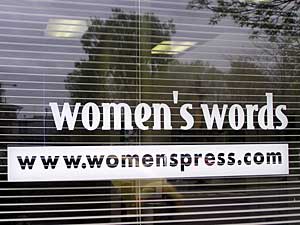|
Audio
Photos
Resources
|
April 30, 2005
 |
| The Minnesota Women's Press is celebrating its 20th year of publishing a biweekly newspaper focused on women's issues. (MPR Photo/Greta Cunningham) |
Minneapolis, Minn. — Back in 1984 the founders, Hoben and Martin, were both educators who were eager to leave what they call the "red tape" of school administration to pursue their dream of producing a newspaper "by women for women."
Mollie Hoben says from the start, she and Glenda Martin proved to be a good team.
"Glenda is a big thinker, big visioner, a lot of excitement and energy for ideas. I tend to be more the day-by-day, 'Let's get it done let's get it out there,'" Hoben says.
The first issue of the newspaper was written and put together at Hoben's dining room table in Minneapolis. Back then, Exacto knives, wax and tape were used to physically assemble the paper. Thee staff is happy to report that today they use computers.
In the early days, the staff was small and all decisions were made by committee. People brought their children to work and put their lunches in Hoben's kitchen refrigerator. Longtime staffers describe it as a good-natured work commune.
Kathy Magnuson is the co-publisher of the Minnesota Women's Press and has been with the paper for its entire 20 years.
"I think a lot has changed, and a lot hasn't changed -- and we're proud of that," says Magnuson.
Magnuson says the mission of the newspaper -- to highlight women's words and values -- has stayed the same.
"What has changed is the stories," Magnuson says. "In our prototype issue we had a feature about Geraldine Ferraro, and there was a lot of excitement that a woman could be vice president."
Magnuson says women are still interested in seeing female politicians succeed. But she says the progress is slow, and women's issues are still not fully covered in mainstream newspapers.
For the past 17 years, The Minnesota Women's Press has conducted several content analyses of how many times women's names are mentioned in the Star Tribune and St. Paul Pioneer Press newspapers.
The current editor of the Minnesota Women's Press, J. Trout Lowen, says the survey looked at 10 issues of both newspapers over a 30-day period. She says when the survey was first conducted in 1988, it found women's names appeared in the newspaper only 17 percent of the time.
Lowen says the results of this year's survey weren't much better. About 21 percent of the names in the two papers were women's names.
"Considering this is 2005, and how many more roles women are fulfilling now -- from the war in Iraq to business ownership -- you would think that we would have a larger percentage in the mainstream newspaper. I think we still feel really underreported," says Lowen.
As to why that's the case, Lowen speculates there are some conventions around what is news that haven't changed that much.
"I also think that we think we're doing a better job than we are. I don't think it's malicious intent -- I don't think people are saying, 'We're not going to cover women's issues,'" says Lowen. "But I think we've seen an improvement and say, 'We're doing much better now.' But no one stops and takes a critical look and says, 'How are we really doing?'"
Lowen says the issue is an important one, because women make up more than half the population and should be included in important discussions.
"If we don't have our voices reported in the newspapers, if the issues that are important to us aren't written about, then the people who make decisions about those issues don't have complete information. I think it's important in so many ways that women's voices be heard," says Lowen.
The newspaper that started at a woman's dining room table now has its headquarters in a real office space, just off University Ave. in Minneapolis. Hoben and Martin printed 25,000 copies of the first edition in 1984 -- the one that featured Geraldine Ferraro. Today, the paper prints 40,000 copies every two weeks.
Co-publisher Kathy Magnuson says she's aware of the fact that other newspapers and publications aimed at women have folded over the years. She says the Minnesota Women's Press has remained healthy because its base of advertisers has continued to grow, and because from the start, the newspaper focused on being a professional publication.
The small staff has always been paid. Magnuson says that's kept turnover low and the quality of the publication high.
"We're a very mission-driven organization. We are not a nonprofit. Some people assume we are, because we're for women we must be needy, so to speak," says Magnuson. "But we started out as a for-profit business very deliberately. We said women's words, ideas and values should have more values in lots of ways, and one of them is in the marketplace."
Longtime Minnesota Women's Press supporter and volunteer Margaret Shryer baked the cake for the paper's first anniversary celebration 20 years ago. She was there for the 20th anniversary party as well. She says a lot has changed over the years, but one thing has stayed constant.
"When you walk through the door, there is such a great feeling of women working at what they love to be working at -- doing good work," says Shryer. "The commitment, the energy that was there the first day, it's still here now."






